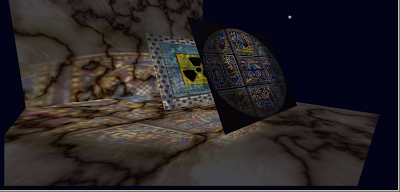 A preliminary shot of my "translucency shadow mapping" engine, showing just the "filtrating light" layer. Light illuminates the glass, which projects its texture on the transparent radiation box, which is supposed to project on the wall as well.
A preliminary shot of my "translucency shadow mapping" engine, showing just the "filtrating light" layer. Light illuminates the glass, which projects its texture on the transparent radiation box, which is supposed to project on the wall as well.Seems working, but actually it doesn't.
The reason is subtle: the more translucent a surface is, the more it shouldn't stop the light; this means that the projected shadow should appear brighter and colorful, but it does not.
This is due to the fact that I create a sort of translucency map by rendering the translucent objects from light's pov, and the resulting image gets darker as the alpha decreases! Some kind of "alpha inversion" is needed, maybe pre-calculated. But this means much more memory, linearly dependent from the number of lights and the resolution of viewport!! Not suitable.
A better solution should be caustic mapping, which is definitively one of the coolest algorythms I've ever seen. The results are impressive, but there are (as usual) some drawbacks: additional geometries (for refractive vertex grid and the projected points), no way to sum up many translucent contributions and so on. It would be interesting to implement it some day, but there's no time to play with it right now.

No comments:
Post a Comment